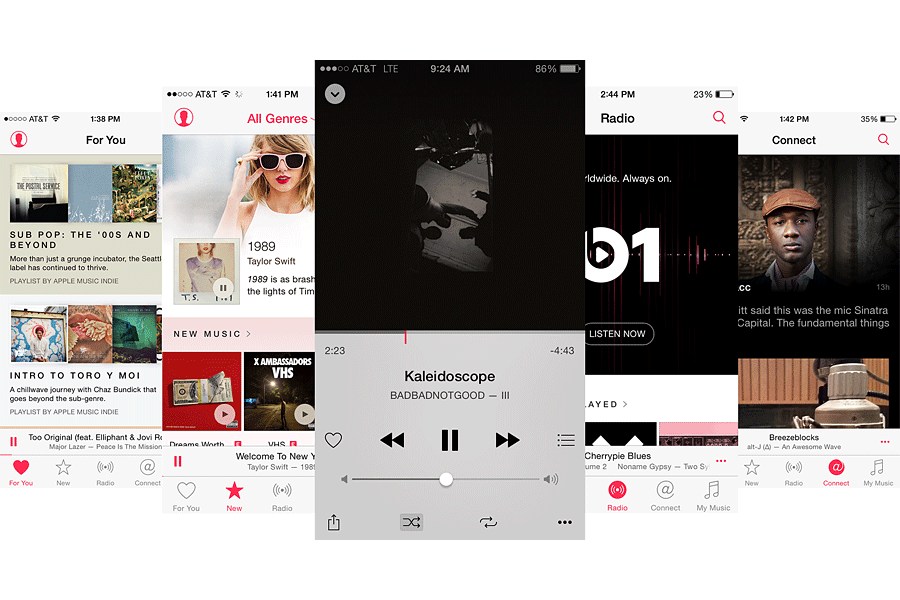A day with Apple Music: What it is and what it isn't
Loading...
Apple unveiled its Apple Music streaming service on Tuesday after it was first announced at the company’s Worldwide Developers Conference last month. It's been hyped by Apple for being the successor to Beats Music and the tech giant’s return to music. But other than the inclusion/exclusion/inclusion of Taylor Swift’s “1989,” no one really knew what to expect from the service. Would it be a serious competitor to other music streaming programs such as Spotify or Pandora, and, more important, would users pay $10 a month after the free trial ends?
After a day with Apple Music, there are some important things to note: first, it doesn’t feel like a music streaming service. Visually, it feels cluttered and the non-obvious search makes it difficult to find the music you’re looking for. The queue system changes rapidly, and the Connect social media platform that the company has been promoting feels more like an e-mail list you’re not able to opt out of than something you’d want to use every day. Overall, the app is more difficult to navigate than expected, but that is likely to improve.
Many see Spotify as Apple Music’s main competitor, and if that’s the battle, Spotify comes out on top – at least in terms of usability. But Spotify has also had years to test its user-experience design, so the first-round clunkiness of Apple Music makes sense. But Apple Music is certainly not Spotify, and the differences between the two may show to be greater than the similarities. With three months of free-trial for users, Apple also has a head start in learning how to manage the program before users are forced to choose whether to pay for the service or not.
As someone that uses streaming services to mostly mirror the personal library I have on my hard drive, I find that Apple Music was difficult to manage. It’s initially unclear what has been added to your music library and how to create and manage your music. As far as simply being able to sift through the tens of thousands of songs I'd want to add to my library, it seems almost counterintuitive. It's difficult to add songs to playlists and organizing the music library centers on a single filter, rather than the range of controls in the previous Music application for iOS.
But after a while, it becomes clear that that wasn’t what Apple was going for. This isn’t that kind of music library streaming service and it’s important to make that distinction.
Apple Music is very much a service for music discovery more than it is for music curation. Where the navigation and library organization system fall short, the playlist features and Beats 1 Radio fight back with robustness.
But is that enough?
When opening the app, after maneuvering through an artist selection process, the user is greeted with a feed showing playlists and artist recommendations. These are compiled with playlists by “Apple Music Editors,” and each of those covers multiple genres and highlighted artists. Users can also start a station based on a singular track, artist, or album, similar to Apple’s “Genius” feature or to Spotify’s radio stations.
This certainly builds on Apple’s “Genius” radio, using its library instead of just your own. It also seems like the suggestion and discovery feature is built to introduce users to artists they may not know. On the first day of Beats 1, DJ Zane Lowe played an assortment of both popular and underground artists. For the conventional listener, most of the music played was unfamiliar, but not unpopular.
Apple is gearing Music to the average user who isn’t as avid at discovering new music, or hasn’t found that “it” new artist in the past few years. It allows users to take a break from the music they always listen to in a curated fashion.
Vulture’s Lauretta Charlton noted, “it gives me an opportunity to make a clean break from my usual tunes and find something foreign to my ears.”
While it’s not clear how Apple will use its users’ libraries to improve recommendations, they do employ at least some noticeable machine learning capabilities. After "starring" Chicago hip-hop artists The O’My’s and Noname Gypsy, Apple Music recommended Mick Jenkins, an artist I like but didn’t have in my library.
While it’s easy for a service to recommend artists that top the charts, it’s much more difficult to curate music that may be less known. Apple Music’s access to the iTunes library may help with drawing connections between lesser-known artists, based on user purchase and playback information.
So will users be willing to pay $10 a month for an improved radio?
Apple Music has many more features, but its execution is somewhat ham-fisted. In addition to the playlists, radio, and music library, users also are given access to Connect, a social media stream where artists post photos, songs, videos, or text. The company markets it as a way to keep up with your favorite artists’ lives in one place, but for now, notes the MIT Technology Review’s Rachel Metz, “it doesn’t feel more exciting than following artists on Twitter and Instagram.”
With so many features bundled into a single package, it’s hard to figure out what exactly Apple Music is trying to do. Your music has been relegated to a single difficult-to-organize tab, and in many ways, it feels more like an extension of iTunes than its own service. Apple Music also allows a user to view and purchase media in iTunes, for those who wish to own their music.
Apple Music mimics iTunes in more ways than one: the once minimal music library app now serves as Apple’s central hub for all media, devices, and product management.
With attempts at radio, streaming, and social media, the company may be trying to do the same with Apple Music.








